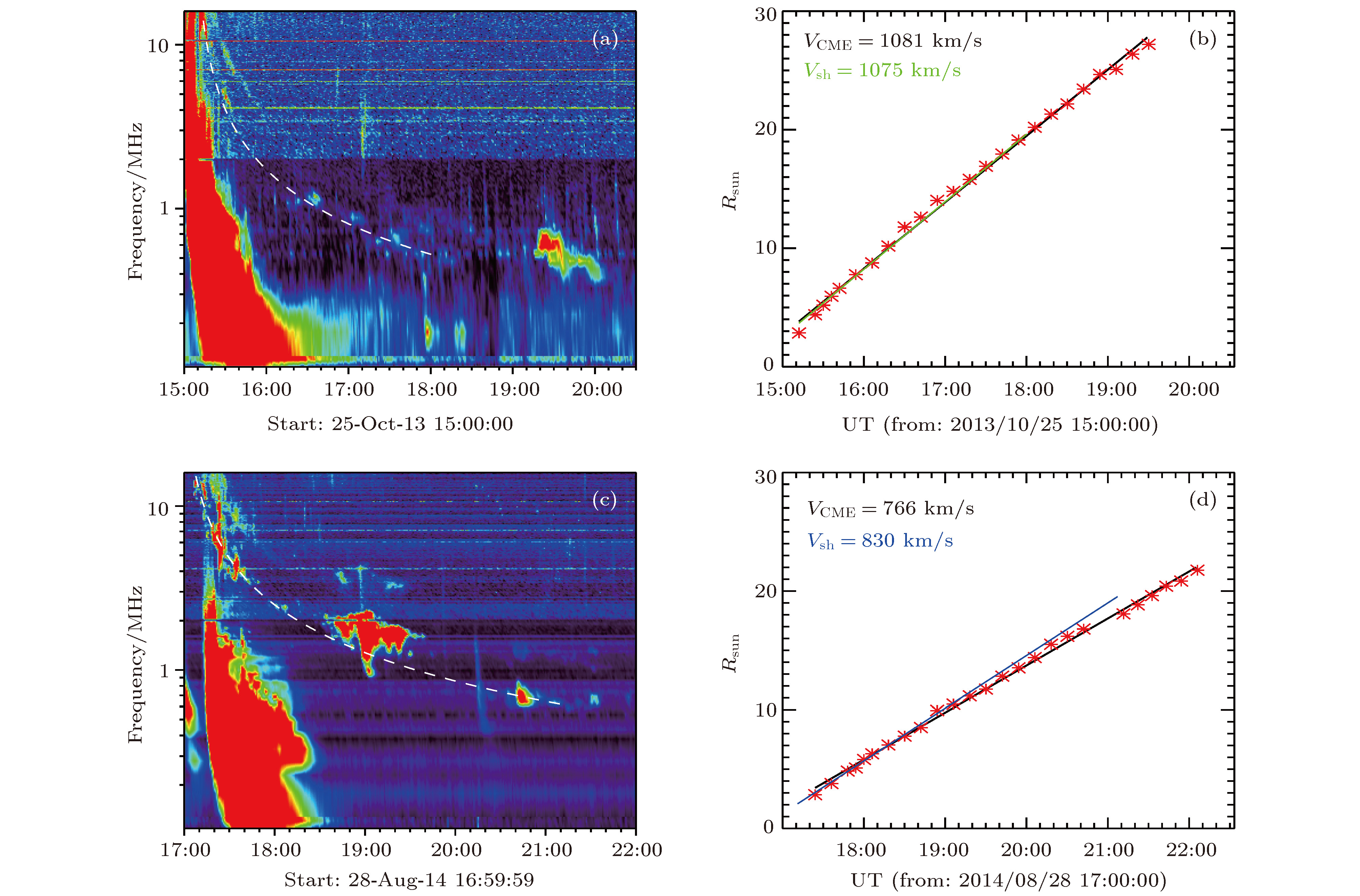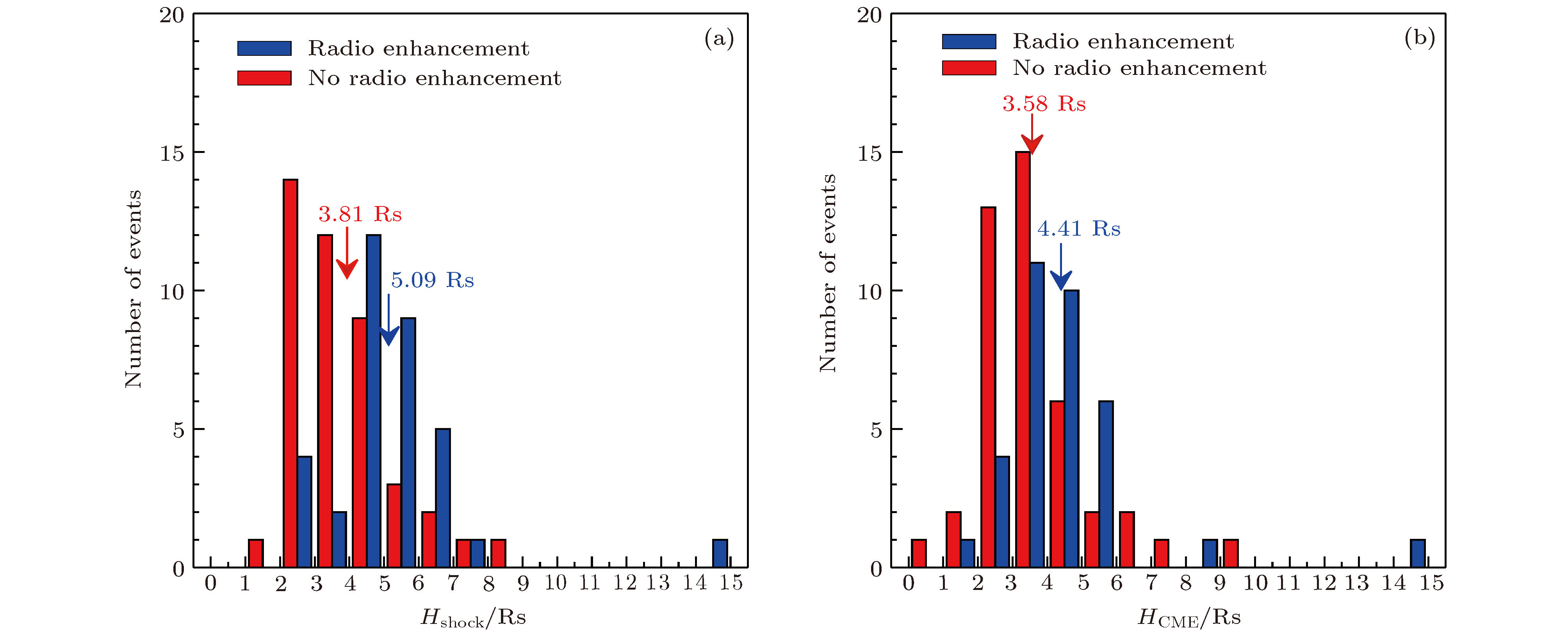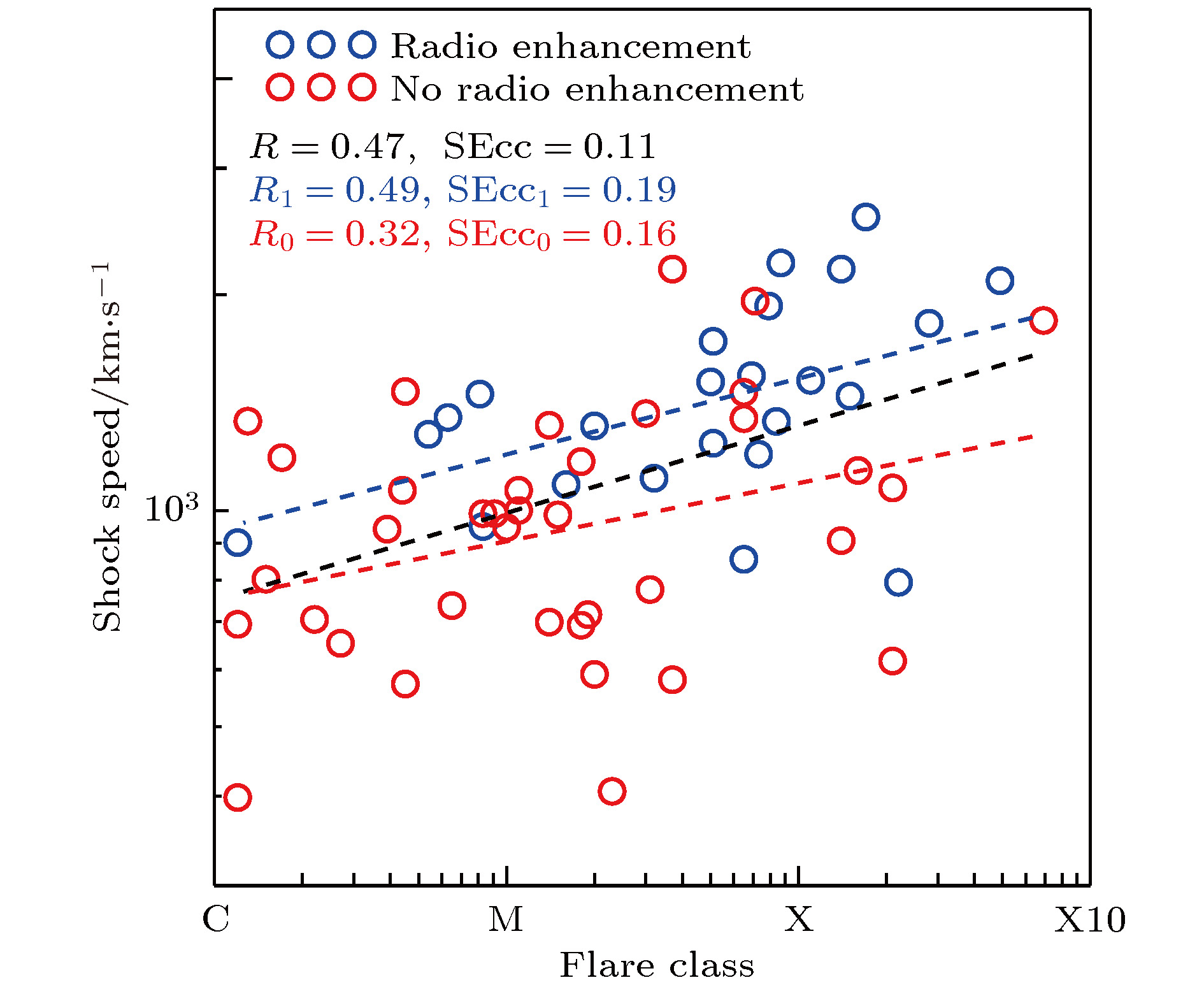-
本文基于Wind/WAVES和STEREO/SWAVES等多卫星射电观测资料, 选择第24太阳活动周2007年1月至2015年12月期间77个II型射电暴样本事件, 拟合其激波速度, 分析了激波参数与日冕物质抛射(CME)、耀斑和太阳高能粒子(SEP)等参数的相关关系及变化规律, 并探讨了射电增强对这些关系的影响. 研究结果显示: 1)在II型射电暴十米百米(DH)波段范围起始时刻, 激波高度比CME前沿高度略高一点, 即激波脱体距离(standoff distance)约0.4 Rs, 且这个高度随CME向外传播而增大. 在低日冕和高日冕, 激波脱体距离随CME速度的变化呈现明显相反的规律; 在低高度上, CME速度快, 激波脱体距离大, 而在高高度上, CME速度慢, 脱体距离大. 2)射电增强伴随事件的CME速度明显大于无射电增强事件; 射电增强伴随事件的激波速度与CME质量、动能的相关性明显好于无射电增强伴随事件. 3)有射电增强伴随的II型射电暴DH波段持续时间与CME速度、质量、动能之间无明显相关性, 而无射电增强事件的DH波段持续时间与这三个量之间呈正相关. 4)产生SEP事件的激波速度明显大于未产生SEP事件的激波速度; 有射电增强伴随的II型射电暴(激波)事件产生SEP事件的比例略高于无射电增强事件(73.5% > 67.4%), 但射电增强事件产生大SEP事件(large SEP event)的比例(67.6%)明显高于无射电增强事件(37.2%). 进一步表明, II型射电暴射电增强可作为其驱动源(激波)大概率产生大SEP事件的辨别信号之一.In this paper, we investigate 77 type-II radio burst events' data observed by Wind/WAVES and STEREO/SWAVES from January 2007 to December 2015. By fitting the frequency-time profile to obtain the corresponding shock velocity, we study the relationship between the parameters of shock and those of coronal mass ejection (CME), solar flare and the associated SEP events, and explore the influences of type II radio enhancement on these relationships. Our findings are as follows. 1) In general, at the onset time of type II radio bursts within deca-hectometric (DH) waveband, the shock front is about 0.4Rs ahead of the leading edge of CME (shock standoff distance), and this distance increases as the CME propagates outward. In the low and high corona, the relationship between shock standoff distance and CME speed indicates a significant difference; the shock standoff distance is correlated with the CME speed positively at the low altitude, but negatively at high altitude. 2) The CME speed of the events with radio enhancement is significantly larger than that with no radio enhancement; and comparing with the events with no radio enhancement, the correlation coefficient between the shock speed and the mass and kinetic energy of the associated CME is significantly high for the events with radio enhancement. 3) There is no correlation between the duration of type II radio burst in DH waveband with enhancement and the speed, mass and kinetic energy of CME. However, it presents a positive correlation for the events with no radio enhancement. 4) Usually the speed of shock that can produce SEP event is obviously higher than that with producing no SEP event. The probability of the SEP generated by the events associated with radio enhancement is slightly higher than with no radio enhancement (73.5% > 67.4%), but for the large SEP events, the generation probability (67.6%) associated with radio enhancement is about one-order of magnitude higher than that with no radio enhancement (37.2%). This conclusion indicates that the type II radio enhancement can be used as one of the signatures of the shock or the radio source that more probably produces a large SEP event.
-
Keywords:
- type II radio burst /
- coronal mass ejection /
- radio enhancement /
- coronal shock
[1] Stewart R T, McCabe M K, Koomen M J, Hansen R T, Dulk G A 1974 Sol. Phys. 36 203
 Google Scholar
Google Scholar
[2] Vršnak B, Lulié S 2000 Sol. Phys. 196 181
 Google Scholar
Google Scholar
[3] Vršnak B, Cliver E W 2008 Sol. Phys. 253 215
 Google Scholar
Google Scholar
[4] Hundhausen A J, Holzer T E, Low B C 2012 J. Geophys. Res-Space. 92 11173
[5] Kahler S W 1982 Astrophys. J. 261 710
 Google Scholar
Google Scholar
[6] Cane H V, Erickson W C, Prestage N P 2002 J. Geophys. Res-Space. 107 1315
 Google Scholar
Google Scholar
[7] Su W, Cheng X, Ding M D, Chen P F, Ning Z J, Ji H S 2016 Astrophys. J. 830 70
 Google Scholar
Google Scholar
[8] Wild J P, McCready L L 1950 Aust. J. Chem. 3 387
 Google Scholar
Google Scholar
[9] Cane H V, Stone R G, Fainberg J 1981 Geophys. Res. Lett. 8 1285
 Google Scholar
Google Scholar
[10] Gopalswamy N, Kaiser M L, Lepping R P, Kahler S W, Ogilvie K, Berdichevsky D, Kondo T, Isobe T, Akioka M 1998 J. Geophys. Res-Space. l 03 307
[11] Kahler S W 2007 Space. Sci. Rev. 129 359
 Google Scholar
Google Scholar
[12] Reiner M J, Kaiser M L, Bougeret J L 2001 J. Geophys. Res. 106 12
[13] Maia D, Pick M, Vourlidas A, Howard R A 2000 Astrophys. J. 528 49
 Google Scholar
Google Scholar
[14] Bain H M, Krucker Säm, Glesener L, Lin R P 2012 Astrophys. J. 750 44
 Google Scholar
Google Scholar
[15] Reiner M J, Vourlidas A, Cyr O C S, Burkepile J T, Howard R A, Kaiser M L, Prestage N P, Bougeret J L 2003 Astrophys. J. 590 533
 Google Scholar
Google Scholar
[16] Cho K S, Lee J, Moon Y J, Dryer M, Bong S C, Kim Y H, Park Y D 2007 Astron. Astrophys. 461 1121
 Google Scholar
Google Scholar
[17] Cho K S, Bong S C, Kim Y H, Moon Y J, Dryer M, Shanmugaraju A, Lee J, Park Y D 2008 Astron. Astrophys. 491 873
 Google Scholar
Google Scholar
[18] Feng S W, Chen Y, Kong X L, Li G, Song H Q, Feng X S, Ying Liu 2012 Astrophys. J. 753 21
 Google Scholar
Google Scholar
[19] Kong X L, Chen Y, Li G, Feng S W, Song H Q, Guo F, Jiao F R 2012 Astrophys. J. 750 158
 Google Scholar
Google Scholar
[20] Gopalswamy N, Yashiro S, Kaiser M L, Howard R A, Bougeret J L 2001 Astrophys. J. 548 91
 Google Scholar
Google Scholar
[21] Ding L G, Wang Z W, Feng L, Li G, Jiang Y 2019 Res. Astron. Astrophys. 19 1
 Google Scholar
Google Scholar
[22] Al-Hamadani F, Pohjolainen S, Valtonen E 2017 Sol. Phys. 292 127
 Google Scholar
Google Scholar
[23] Kahler S W 2001 J. Geophys. Res. 106 10
[24] Shen C L, Wang Y M, Ye P Z, Zhao X P, Gui B, Wang S 2007 Astrophys. J. 670 849
 Google Scholar
Google Scholar
[25] Gopalswamy N, Aguilar-Rodriguez E, Yashiro S, Nunes S, Kaiser M L, Howard R A 2005 J. Geophys. Res. 110 12
[26] Winter L M, Ledbetter K 2015 Astrophys. J. 809 105
 Google Scholar
Google Scholar
[27] Marque C, Posner A, Klein K L 2006 Astrophys. J. 642 1222
 Google Scholar
Google Scholar
[28] Müller-Mellin R, Kunow H, Fleißner V, Pehlke E, Rode E, Röschmann N, Scharmberg C, Sierks H, Rusznyak P, Mckenna-Lawlor S, Elendt I, Sequeiros J, Meziat D, Sanchez S, Medina J, Peral L D, Witte M, Marsden R, Henrion J 1995 Sol. Phys. 162 483
 Google Scholar
Google Scholar
[29] Von Rosenvinge T T, Reames D V, Baker R, Hawk J, Nolan J T, Ryan L, Shuman S, Wortman K A, Mewaldt R A, Cummings A C, Cook W R, Labrador A W, Leske R A, Wiedenbeck M E 2008 Space. Sci. Rev. 136 391
 Google Scholar
Google Scholar
[30] 王智伟, 丁留贯, 周坤论, 乐贵明 2018 地球 61 3515
 Google Scholar
Google Scholar
Wang Z W, Ding L G, Zhou K L, Yue G M 2018 Chin. J. Geophys. 61 3515
 Google Scholar
Google Scholar
[31] Vršnak B, Magdalenić J, Zlobec P 2004 Astron. Astrophys. 413 753
 Google Scholar
Google Scholar
[32] Saito K, Poland A I, Munro R H 1977 Sol. Phys. 55 121
 Google Scholar
Google Scholar
[33] Gopalswamy N, Yashiro S 2011 Astrophys. J. 736 17
 Google Scholar
Google Scholar
[34] Mäkelä P, Gopalswamy N, Akiyama S, Xie H, Yashiro S, Recently M 2015 Astrophys. J. 806 13
 Google Scholar
Google Scholar
[35] Kocharov L, Pohjolainen S, Mishev A, Reiner M J, Lee J, Laitinen T, Didkovsky L V, Pizzo V J, Kim R, Klassen A, Karlicky M, Cho K S, Gary D E, Usoskin I, Valtonen E, Vainio R 2017 Astrophys. J. 839 79
 Google Scholar
Google Scholar
[36] Mittal N, Verma V K 2017 New. Astron. 50 60
 Google Scholar
Google Scholar
[37] Mujiber Rahman A, Shanmugaraju A, Umapathy S, Moon Y J 2013 J. Atmos. Sol-Terr. Phys 105 106
-
图 2 (a) 81个候选事件拟合激波速度与CME速度之间的关系. 蓝色圈代表激波速度与CME速度相符事件, 红色三角代表拟合激波速度远小于CME速度事件, 黑色实线是所有事件的线性拟合, 蓝色实线是所有相符事件的线性拟合; (b)拟合激波速度与CME速度之差的统计直方图
Fig. 2. (a) Scatter plot of fitting shock speed and CME speed for all 81 candidate events. The blue circle represents the shock speed coincides with the CME speed event, the red triangle represents the events that the fitting shock speed is much smaller than the CME speed, the black solid line is the linear fit of all events, and the blue solid line is the linear fit of all 77 coincident or normal events. (b) Distribution of the speed difference between shock speed and CME speed.
图 3 所有候选事件DH II型射电暴起始时刻激波高度与CME高度之间的关系. (a)蓝色圈是正常事件, 红色三角是异常事件, 黑色实线是所有事件的拟合线, 蓝色实线是正常事件起始高度的拟合线, 黑色虚线斜率为1. (b) DH II型射电暴起始时刻激波高度与CME高度差的直方图, 蓝色条为正常事件, 红色条为异常事件
Fig. 3. Scatter plot of shock height and CME height at the onset of type IIs radio burst for all 81 candidate events. (a) The blue circle is a normal event, the red triangle is an abnormal event, the black solid line is the fitted line for all events, the blue solid line is the fitted line for the normal event start height, and the black dotted line slope is 1. (b) histogram of the difference between the shock height and the CME height at the start of the type IIs radio burst. The blue bar is a normal event and the red bar is an abnormal event.
图 5 DH II型射电暴起始时刻(a)激波高度和(b) CME前沿高度的统计直方图. 蓝色为有射电增强的事件, 红色为无射电增强的事件
Fig. 5. Statistical histogram of the shock height and the CME leading edge height at the start time of DH type II radio bursts for normal events. Blue is an event with radio enhancement, and red is an event with no radio enhancement.
图 7 (a)激波速度与CME质量的相关性, (b)激波速度与CME动能的关系. 蓝色圈为有射电增强的事件, 红色圈为无射电增强的事件, 黑色虚线为所有事件的拟合线, 蓝色虚线为有射电增强事件的线性拟合, 红色虚线为无射电增强事件的线性拟合
Fig. 7. Scatter plot of shock speed and CME mass、kinetic energy for normal events. The blue circle is an event with enhanced radio enhancement, the red circle is an event with no radio enhancement, the black dotted line is the fitted line for all events, the blue dashed line is a linear fit result for radio-enhanced events, and the red dashed line is a linear fit result for no radio-enhanced events.
图 8 激波速度与耀斑等级的相关性, 蓝色圈为有射电增强的事件, 红色圈为无射电增强的事件, 黑色虚线为所有事件的线性拟合, 蓝色虚线为有射电增强事件的线性拟合, 红色虚线为无射电增强的线性拟合.
Fig. 8. Scatter plot between shock speed and flare class for normal events, blue circle for radio-enhanced events, red circle for no radio-enhanced events, black dashed line for linear fitting of all events, and blue dashed line is a linear fit for radio-enhanced events, the red dashed line is a linear fit for no radio enhancement events.
图 9 DH II型射电暴持续时间与CME速度(a)、质量(b)和动能(c)的相关性, 蓝色圈为有射电增强的事件, 红色圈为无射电增强的事件. 黑色虚线为所有事件的线性拟合, 蓝色虚线为有射电增强事件的线性拟合, 红色虚线为无射电增强的线性拟合
Fig. 9. Scatter plot of DH type II radio burst duration and CME speed(a), CME mass(b) and CME kinetic energy(c) for normal events. The blue circle is an event with radio enhancement, and the red circle is an event with no radio enhancement. The black dashed line is a linear fit for all events, the blue dashed line is a linear fit for radio-enhanced events, and the red dashed line is a linear fit for no radio-enhancement events.
图 11 (a) SEP事件峰值与激波速度的相关关系, 黑色虚线为所有事件的线性拟合, 蓝色虚线为有射电增强事件的线性拟合, 红色虚线为无射电增强的线性拟合. (b)有无SEP事件的激波速度的统计直方图
Fig. 11. (a) Scatter plot between SEP event peak and shock speed for normal events. black dashed line is a linear fit for all events, blue dashed line is a linear fit for radio enhanced events, and red dashed line is a linear fit for no radio enhancement. (b) Statistical histogram of shock speed associated with or without SEP events for normal events
-
[1] Stewart R T, McCabe M K, Koomen M J, Hansen R T, Dulk G A 1974 Sol. Phys. 36 203
 Google Scholar
Google Scholar
[2] Vršnak B, Lulié S 2000 Sol. Phys. 196 181
 Google Scholar
Google Scholar
[3] Vršnak B, Cliver E W 2008 Sol. Phys. 253 215
 Google Scholar
Google Scholar
[4] Hundhausen A J, Holzer T E, Low B C 2012 J. Geophys. Res-Space. 92 11173
[5] Kahler S W 1982 Astrophys. J. 261 710
 Google Scholar
Google Scholar
[6] Cane H V, Erickson W C, Prestage N P 2002 J. Geophys. Res-Space. 107 1315
 Google Scholar
Google Scholar
[7] Su W, Cheng X, Ding M D, Chen P F, Ning Z J, Ji H S 2016 Astrophys. J. 830 70
 Google Scholar
Google Scholar
[8] Wild J P, McCready L L 1950 Aust. J. Chem. 3 387
 Google Scholar
Google Scholar
[9] Cane H V, Stone R G, Fainberg J 1981 Geophys. Res. Lett. 8 1285
 Google Scholar
Google Scholar
[10] Gopalswamy N, Kaiser M L, Lepping R P, Kahler S W, Ogilvie K, Berdichevsky D, Kondo T, Isobe T, Akioka M 1998 J. Geophys. Res-Space. l 03 307
[11] Kahler S W 2007 Space. Sci. Rev. 129 359
 Google Scholar
Google Scholar
[12] Reiner M J, Kaiser M L, Bougeret J L 2001 J. Geophys. Res. 106 12
[13] Maia D, Pick M, Vourlidas A, Howard R A 2000 Astrophys. J. 528 49
 Google Scholar
Google Scholar
[14] Bain H M, Krucker Säm, Glesener L, Lin R P 2012 Astrophys. J. 750 44
 Google Scholar
Google Scholar
[15] Reiner M J, Vourlidas A, Cyr O C S, Burkepile J T, Howard R A, Kaiser M L, Prestage N P, Bougeret J L 2003 Astrophys. J. 590 533
 Google Scholar
Google Scholar
[16] Cho K S, Lee J, Moon Y J, Dryer M, Bong S C, Kim Y H, Park Y D 2007 Astron. Astrophys. 461 1121
 Google Scholar
Google Scholar
[17] Cho K S, Bong S C, Kim Y H, Moon Y J, Dryer M, Shanmugaraju A, Lee J, Park Y D 2008 Astron. Astrophys. 491 873
 Google Scholar
Google Scholar
[18] Feng S W, Chen Y, Kong X L, Li G, Song H Q, Feng X S, Ying Liu 2012 Astrophys. J. 753 21
 Google Scholar
Google Scholar
[19] Kong X L, Chen Y, Li G, Feng S W, Song H Q, Guo F, Jiao F R 2012 Astrophys. J. 750 158
 Google Scholar
Google Scholar
[20] Gopalswamy N, Yashiro S, Kaiser M L, Howard R A, Bougeret J L 2001 Astrophys. J. 548 91
 Google Scholar
Google Scholar
[21] Ding L G, Wang Z W, Feng L, Li G, Jiang Y 2019 Res. Astron. Astrophys. 19 1
 Google Scholar
Google Scholar
[22] Al-Hamadani F, Pohjolainen S, Valtonen E 2017 Sol. Phys. 292 127
 Google Scholar
Google Scholar
[23] Kahler S W 2001 J. Geophys. Res. 106 10
[24] Shen C L, Wang Y M, Ye P Z, Zhao X P, Gui B, Wang S 2007 Astrophys. J. 670 849
 Google Scholar
Google Scholar
[25] Gopalswamy N, Aguilar-Rodriguez E, Yashiro S, Nunes S, Kaiser M L, Howard R A 2005 J. Geophys. Res. 110 12
[26] Winter L M, Ledbetter K 2015 Astrophys. J. 809 105
 Google Scholar
Google Scholar
[27] Marque C, Posner A, Klein K L 2006 Astrophys. J. 642 1222
 Google Scholar
Google Scholar
[28] Müller-Mellin R, Kunow H, Fleißner V, Pehlke E, Rode E, Röschmann N, Scharmberg C, Sierks H, Rusznyak P, Mckenna-Lawlor S, Elendt I, Sequeiros J, Meziat D, Sanchez S, Medina J, Peral L D, Witte M, Marsden R, Henrion J 1995 Sol. Phys. 162 483
 Google Scholar
Google Scholar
[29] Von Rosenvinge T T, Reames D V, Baker R, Hawk J, Nolan J T, Ryan L, Shuman S, Wortman K A, Mewaldt R A, Cummings A C, Cook W R, Labrador A W, Leske R A, Wiedenbeck M E 2008 Space. Sci. Rev. 136 391
 Google Scholar
Google Scholar
[30] 王智伟, 丁留贯, 周坤论, 乐贵明 2018 地球 61 3515
 Google Scholar
Google Scholar
Wang Z W, Ding L G, Zhou K L, Yue G M 2018 Chin. J. Geophys. 61 3515
 Google Scholar
Google Scholar
[31] Vršnak B, Magdalenić J, Zlobec P 2004 Astron. Astrophys. 413 753
 Google Scholar
Google Scholar
[32] Saito K, Poland A I, Munro R H 1977 Sol. Phys. 55 121
 Google Scholar
Google Scholar
[33] Gopalswamy N, Yashiro S 2011 Astrophys. J. 736 17
 Google Scholar
Google Scholar
[34] Mäkelä P, Gopalswamy N, Akiyama S, Xie H, Yashiro S, Recently M 2015 Astrophys. J. 806 13
 Google Scholar
Google Scholar
[35] Kocharov L, Pohjolainen S, Mishev A, Reiner M J, Lee J, Laitinen T, Didkovsky L V, Pizzo V J, Kim R, Klassen A, Karlicky M, Cho K S, Gary D E, Usoskin I, Valtonen E, Vainio R 2017 Astrophys. J. 839 79
 Google Scholar
Google Scholar
[36] Mittal N, Verma V K 2017 New. Astron. 50 60
 Google Scholar
Google Scholar
[37] Mujiber Rahman A, Shanmugaraju A, Umapathy S, Moon Y J 2013 J. Atmos. Sol-Terr. Phys 105 106
计量
- 文章访问数: 7807
- PDF下载量: 54
- 被引次数: 0














 下载:
下载:










